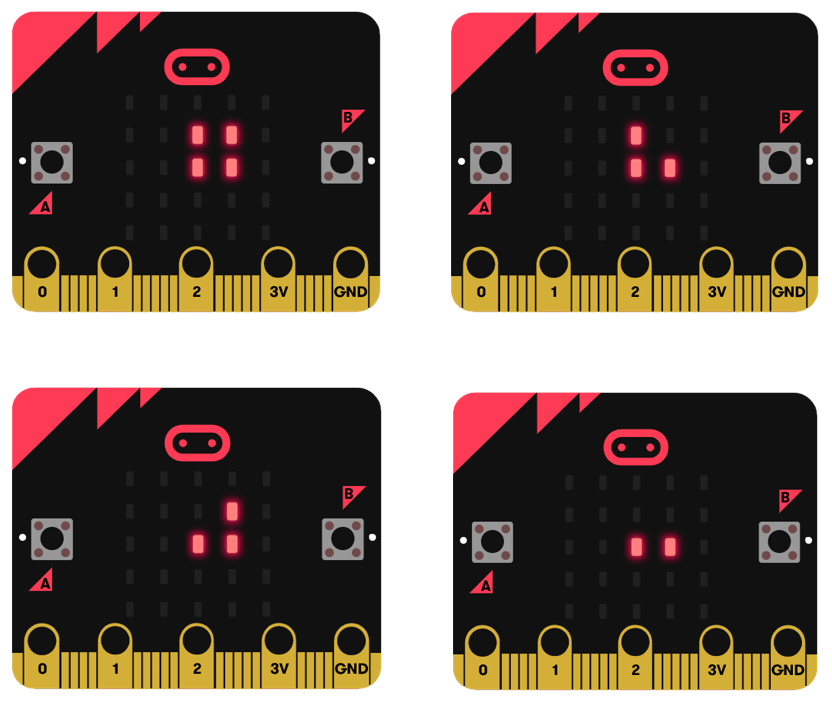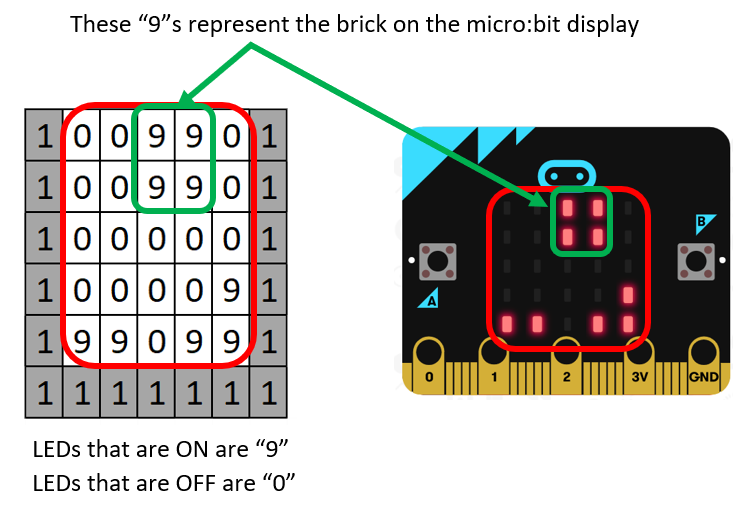Tetris on a micro:bit
In this version of the classic Tetris game, we will use the following four bricks.

Controls
- A button – Move left
- B button – Move right
- A & B button together – Rotate brick
How the LED grid works
The micro:bit has a 5 x 5 grid of LEDs (25 in total). For this game we will use these LEDs as the “screen” to play on.
The LEDs are set in the code to value “9” for ON and value “0” for OFF. The brightness of the LED can be controlled by using a lower value instead of 9.
The border shown below as “1” is not displayed since it is outside of the available LEDs but is used to keep track of the edge of the screen.


Keep scrolling for the downloadable code.
Copy the Python code below into the micro:bit coding site as per the YouTube video.
Shortcut! If you just want to download the pre-compiled code, click here, extract the zip file and copy the hex file to your microbit.
Python Code for micro:bit
[python]
from microbit import *
from random import choice
#Set up the tetris grid
grid=[[1,0,0,0,0,0,1],[1,0,0,0,0,0,1],[1,0,0,0,0,0,1],[1,0,0,0,0,0,1],[1,0,0,0,0,0,1],[1,1,1,1,1,1,1]]
#Store a list of 4 bricks, each brick is a 2×2 grid
bricks = [[9,9],[9,0]],[[9,9],[0,9]],[[9,9],[9,9]],[[9,9],[0,0]]
#select a brick randomly and position it at the center/top of the grid (y=0,x=3)
brick = choice(bricks)
x=3
y=0
frameCount=0
#A function to return the maximum of two values
def max(a,b):
if a>=b:
return a
else:
return b
#A function to hide the 2×2 brick on the LED screen
def hideBrick():
if x>0:
display.set_pixel(x-1,y,grid[y][x])
if x<5:
display.set_pixel(x+1-1,y,grid[y][x+1])
if x>0 and y<4:
display.set_pixel(x-1,y+1,grid[y+1][x])
if x<5 and y<4:
display.set_pixel(x+1-1,y+1,grid[y+1][x+1])
#A function to show the 2×2 brick on the LED screen
def showBrick():
if x>0:
display.set_pixel(x-1,y,max(brick[0][0],grid[y][x]))
if x<5:
display.set_pixel(x+1-1,y,max(brick[0][1],grid[y][x+1]))
if x>0 and y<4:
display.set_pixel(x-1,y+1,max(brick[1][0],grid[y+1][x]))
if x<5 and y<4:
display.set_pixel(x+1-1,y+1,max(brick[1][1],grid[y+1][x+1]))
#A function to rotate the 2×2 brick
def rotateBrick():
pixel00 = brick[0][0]
pixel01 = brick[0][1]
pixel10 = brick[1][0]
pixel11 = brick[1][1]
#Check if the rotation is possible
if not ((grid[y][x]>0 and pixel00>0) or (grid[y+1][x]>0 and pixel10>0) or (grid[y][x+1]>0 and pixel01>0) or (grid[y+1][x+1]>0 and pixel11>0)):
hideBrick()
brick[0][0] = pixel10
brick[1][0] = pixel11
brick[1][1] = pixel01
brick[0][1] = pixel00
showBrick()
#A function to move/translate the brick
def moveBrick(delta_x,delta_y):
global x,y
move=False
#Check if the move if possible: no collision with other blocks or borders of the grid
if delta_x==-1 and x>0:
if not ((grid[y][x-1]>0 and brick[0][0]>0) or (grid[y][x+1-1]>0 and brick[0][1]>0) or (grid[y+1][x-1]>0 and brick[1][0]>0) or (grid[y+1][x+1-1]>0 and brick[1][1]>0)):
move=True
elif delta_x==1 and x<5:
if not ((grid[y][x+1]>0 and brick[0][0]>0) or (grid[y][x+1+1]>0 and brick[0][1]>0) or (grid[y+1][x+1]>0 and brick[1][0]>0) or (grid[y+1][x+1+1]>0 and brick[1][1]>0)):
move=True
elif delta_y==1 and y<4:
if not ((grid[y+1][x]>0 and brick[0][0]>0) or (grid[y+1][x+1]>0 and brick[0][1]>0) or (grid[y+1+1][x]>0 and brick[1][0]>0) or (grid[y+1+1][x+1]>0 and brick[1][1]>0)):
move=True
#If the move is possible, update x,y coordinates of the brick
if move:
hideBrick()
x+=delta_x
y+=delta_y
showBrick()
#Return True or False to confirm if the move took place
return move
#A function to check for and remove completed lines
def checkLines():
global score
removeLine=False
#check each line one at a time
for i in range(0, 5):
#If 5 blocks are filled in (9) then a line is complete (9*5=45)
if (grid[i][1]+grid[i][2]+grid[i][3]+grid[i][4]+grid[i][5])==45:
removeLine = True
#Increment the score (10 pts per line)
score+=10
#Remove the line and make all lines above fall by 1:
for j in range(i,0,-1):
grid[j] = grid[j-1]
grid[0]=[1,0,0,0,0,0,1]
if removeLine:
#Refresh the LED screen
for i in range(0, 5):
for j in range(0, 5):
display.set_pixel(i,j,grid[j][i+1])
return removeLine
gameOn=True
score=0
showBrick()
#Main Program Loop – iterates every 50ms
while gameOn:
sleep(50)
frameCount+=1
#Capture user inputs
if button_a.is_pressed() and button_b.is_pressed():
rotateBrick()
elif button_a.is_pressed():
moveBrick(-1,0)
elif button_b.is_pressed():
moveBrick(1,0)
#Every 15 frames try to move the brick down
if frameCount==15 and moveBrick(0,1) == False:
frameCount=0
#The move was not possible, the brick stays in position
grid[y][x]=max(brick[0][0],grid[y][x])
grid[y][x+1]=max(brick[0][1],grid[y][x+1])
grid[y+1][x]=max(brick[1][0],grid[y+1][x])
grid[y+1][x+1]=max(brick[1][1],grid[y+1][x+1])
if checkLines()==False and y==0:
#The brick has reached the top of the grid – Game Over
gameOn=False
else:
#select a new brick randomly
x=3
y=0
brick = choice(bricks)
showBrick()
if frameCount==15:
frameCount=0
#End of Game
sleep(2000)
display.scroll("Game Over: Score: " + str(score))
[/python]
